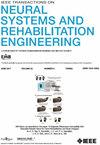Probing Vestibular Function With Frequency- Modulated Electrical Vestibular Stimulation
IF 4.8
2区 医学
Q2 ENGINEERING, BIOMEDICAL
IEEE Transactions on Neural Systems and Rehabilitation Engineering
Pub Date : 2025-04-25
DOI:10.1109/TNSRE.2025.3564388
引用次数: 0
Abstract
Electrical vestibular stimulation (EVS) is a non-invasive technique used to affect the vestibular system. It disturbs the sense of balance and evokes false sensations of movement by modulating the firing rate of vestibular afferents. This study used frequency-modulated EVS (FM-EVS) combined with center-of pressure (CoP) measurements to investigate the strength-frequency relationship of the stimulation and the evoked responses. CoP responses to FM-EVS were measured for ten subjects. Stimulus waveforms composed of linear chirps were compared to the evoked CoP responses, producing estimates of the highest frequencies at which EVS affected the CoP for stimulation currents of 0.75, 1.0 and 1.5 mA. Latency was calculated as the delay between the CoP response and stimulus. In situ electric field in the vestibular system was determined using fifteen high-resolution anatomical head models using the finite element method. CoP responses were evoked at up to用频率调制前庭电刺激探测前庭功能
前庭电刺激(EVS)是一种用于影响前庭系统的非侵入性技术。它通过调节前庭传入神经的放电速率来扰乱平衡感和唤起运动的虚假感觉。本研究采用调频EVS (FM-EVS)结合压力中心(CoP)测量来研究刺激与诱发反应的强度-频率关系。测量了10名受试者对FM-EVS的CoP反应。将由线性啁啾组成的刺激波形与诱发的CoP反应进行比较,得出了在0.75、1.0和1.5 mA的刺激电流下EVS影响CoP的最高频率。潜伏期计算为CoP反应与刺激之间的延迟。利用15个高分辨率头颅解剖模型,采用有限元法测定前庭系统的原位电场。分别在0.75 mA、1.0 mA、1.5 mA、$10.5~\pm ~1.2$ Hz和$5.5~\pm ~1.1$ Hz下诱发CoP反应。前庭电场为每1ma电流$175~\pm ~ $ 23$ mVm ${}^{-{1}}$。研究结果揭示了EVS诱发运动反应的强度-频率依赖性,并对原位电场强度进行了估计,可为未来人体电磁场暴露指南的制定或EVS和经颅电刺激研究的设计提供参考。
本文章由计算机程序翻译,如有差异,请以英文原文为准。
求助全文
约1分钟内获得全文
求助全文
来源期刊
CiteScore
8.60
自引率
8.20%
发文量
479
审稿时长
6-12 weeks
期刊介绍:
Rehabilitative and neural aspects of biomedical engineering, including functional electrical stimulation, acoustic dynamics, human performance measurement and analysis, nerve stimulation, electromyography, motor control and stimulation; and hardware and software applications for rehabilitation engineering and assistive devices.

 求助内容:
求助内容: 应助结果提醒方式:
应助结果提醒方式:


